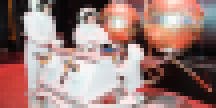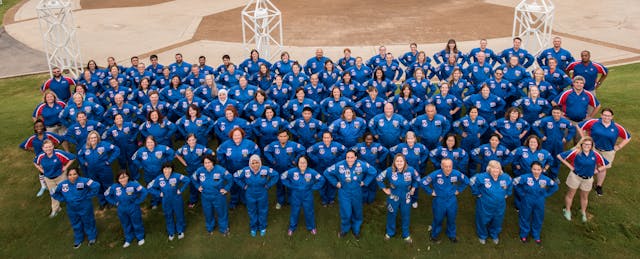I was a small fish in a big pond—surrounded by rockstar educators from 34 countries. Most of them, maybe all of them possessed content knowledge that surpassed mine by leaps and bounds.
My team was embarking on an engineering design mission; we were tasked with constructing a spacecraft that would successfully land on Mars, while safely carrying a space vehicle called a rover. I was completely out of my element. But I looked at our limited supplies—cardboard, tape, string, tissue paper and grocery sacks—and was immediately reminded of my son’s parachute fireworks. They were made of tissue, circular and reinforced on their tie-in locations. In that moment, I realized I have something to offer.
I wasn’t the leader, or the most experienced teammate, but I had a connection and an idea. My team listened, improved upon my idea, and we had the most successful parachute (if I might say so myself!) even if we didn’t exactly have a smooth landing.
A core element of personalized learning is meeting kids “where they are.” To do this, we need to support students in figuring out where their strengths and interests lie and where they need to grow so that they can identify what they want to learn and how they want to learn it.
This takes an immense amount of self-reflection and self-awareness, and we demand it from our kids everyday—but we rarely engage in the process ourselves.
The Honeywell Educators at Space Academy (HESA), a professional (and personal) development program for middle-school science teachers, gave me an unexpected opportunity to experience many of the emotions that students live each day. I returned to my classroom a more empathetic version of my teaching self—better able to help students identify where they are, and where they want to go.
The goal of the program is to expose teachers to high-quality STEAM learning experiences so they can be implemented in the classroom. Through this program teachers are challenged to participate in mission simulations, astronaut training challenges, engineering design challenges and team-building exercises. Two-hundred participants are accepted each summer out of a competitive pool of applicants to attend the five-day program, which takes place at the U.S. Space and Rocket Center in Huntsville, Alabama.

My motivation to apply for HESA stemmed from a burning desire to connect content with my students in the most meaningful way possible. Sure, I frequented Teachers Pay Teachers and Pinterest to keep things fresh and cute, but was I providing the deepest learning experiences that built intrinsic motivation among all of my students
Honestly, I wasn’t sure. I had to see what was out there so I could beg, borrow, steal, and collaborate my way to a better classroom. The passionate persistence of my close teacher friends gave me the extra encouragement I needed to apply. They insisted that it would forever change my teaching life. They were right. I was accepted for the summer 2017 program, and was completely over the moon (pun intended).
Each teacher came to HESA with different goals, but all of us left as stronger teachers. That is what I want in my class—for each student to come in with different personal goals, but for all to leave as better humans because they had the “Fritchie-experience.” I want them to leave my room with the confidence and conviction to attack new scenarios and apply what they learn to enhance their lives and the lives of others.
At HESA, it felt like everyone knew more than me, and that was uncomfortable at times—but I really appreciated how the experience helped me understand how many of my students must feel when they enter a new school, grade, or class.
Space camp put me in control of my learning and personal growth. It provided me with the location, people and activities, but I made it meaningful and applicable to my life because I saw the value and I was connected with what I was learning. Similarly, personalized learning is about offering students the experiences, opportunities and resources that allow them to take an active role in their learning, and giving them space to do so.
In the HESA program I was teamed up with teachers from around the world. We did some team-building exercises that were designed to learn the core values of working as a team: communication, collaboration, respect and trust. We were reminded of those values often and our attention was focused on building those skills as we entered any task. HESA presented us with hands-on activities to develop those skills and practice them while accomplishing a goal together.

In addition to activities, we also had an opportunity to learn from some incredible speakers, including a former astronaut, NASA mission control specialists, NASA engineers, and a world-renowned author. One speaker, Ed Buckbee, a founder of space camp, told a story about a worker on a rocket who worked tirelessly into the wee hours of the morning with one goal: to make sure his part of the rocket’s equipment worked. Not for a raise, or an incentive, but so that the rocket could launch successfully. It’s a simple story with a common lesson, but for some reason it changed me to my core.
Shifting perspective from “I have to know everything deeply,” to “I have to make sure my part works” alleviated the unnecessary pressure to do everything well. I have to be sure I do my job and I do it well so that we can all be successful, but I don’t have to do it all—I can, and should encourage others to shine and support them in doing so. This is the most important lesson I learned from HESA—and I plan to bring it back to my classroom.
Each student plays an important role in our class and must do his or her part to be sure we all learn and grow together. It’s not about candy, gold stars, first place or a grade that trumps someone else’s. It’s about understanding that every individual has strengths, passions, talents and interests that drive them, and that each learner has a unique perspective and brings value to classroom conversations. This goes beyond the relationship between teachers and students and into the bonds forged with and between parents and school leaders.
This year, I’m committing to providing my students with opportunities similar to the ones I was exposed to at space camp—learning experiences that put students in the driver’s seat. Even though our crew trainers had an extensive knowledge of all things NASA, they gave us just enough information to get us going, and let us take it from there. They didn’t tell us what we needed to know; they led quick information sessions where our role was to listen, absorb and apply our knowledge during a mission, simulation or task. These tactics forced all of us to rely on one another to recall and interpret information from the informational sessions.

By giving us more space to explore together, we quickly found out who was assertive, passive, creative, inquisitive—our roles and responsibilities organically revealed themselves as our natural strengths emerged.
To mimic this type of learning environment, I have to relinquish some of my long-time teaching habits, which isn’t easy. I need to give up the old view that I’m the knower of all things and offer my students just enough information to get the conversation, activity or project started, letting them rely on one another to evolve it.
Beyond bringing some of the teaching methodologies back to my classroom, I also plan to incorporate some of the very same activities I did at space camp. My students will construct landers and rovers too. They’ll create ablative heat shields, and they’ll work together to launch a weather balloon just like the NASA team launches a rocket.

Assuming there will be failure along the way, as there is with all teaching and learning, we’ll embrace those struggles, learn from them, improve and move forward. Students will learn to identify their strengths and areas for refinement through honest self-assessment and de-briefing after their missions and tasks. My little primary school doesn’t know what’s coming—my classroom is going to become a mini-NASA space camp—blue flight suit and all!
Becky Fritchie is a 5th grade math and science teacher at Spanish Lake Primary School in Geismar, Louisiana.


